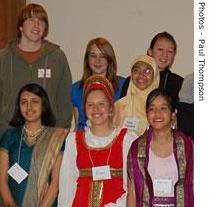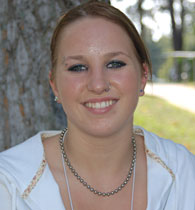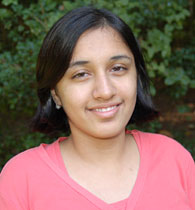VOA慢速英语 2008 0331b(在线收听)
THIS IS AMERICA - Want to Be a Foreign Exchange Student? First Do Some Homework
''You should not leave your country thinking 'Oh, wow, cool, a year of holiday,' because it's also hard. But at the same time it's so cool,'' says an Italian teen studying in the U.S. Transcript of radio broadcast:
30 March 2008
VOICE ONE:
Welcome to THIS IS AMERICA in VOA Special English. I'm Bob Doughty.
VOICE TWO:
And I'm Faith Lapidus. This week on our program, we talk about foreign exchange students in the United States.
(MUSIC)
VOICE ONE:
More than twenty-nine thousand foreign exchange students attended American high schools last year. The State Department says the teenagers came from one hundred nine countries.
Foreign exchange students get the chance to learn more about a culture and its people. They make new friends and experience new places. But they can also experience problems being far from home, among people they do not know and may not understand.
The way many describe it, the experience is exciting and frightening at the same time.
VOICE TWO:
In the past, exchange students usually had limited contact with their host families before meeting them. But times have changed. Today, exchange students may know a lot about their host family before they ever leave home. E-mails go back and forth; pictures of families, homes and pets are shared.
E-mail and cell phones also make it easier for the students to keep in contact with their own families back home.
VOICE ONE:
 |
| Some exchange students attending high schools in Virginia |
Exchange groups are supposed to provide a contact person, or liaison, to help students in case they have any problems.
This is what happened with a boy from Argentina we'll call Juan Carlos.
Juan Carlos liked sports; his American host family did not. He liked to go out with friends; his host parents did not approve. And they did not think he was doing well enough in school: he was getting average grades. The host parents discussed these issues with his liaison.
And the solution? A new family was found for Juan Carlos. The new family included two boys who played soccer on local teams. Juan Carlos joined those teams and was much happier with his new family. Not only that, his grades improved.
(MUSIC)
VOICE TWO:
Exchange students have to speak English well enough to attend an American high school. But some students find it takes weeks or months for them to understand everything they read or hear.
One girl from Switzerland told her exchange group that some students at her American high school made fun of her accent. An exchange volunteer asked how many languages she spoke. The girl said her native language was Swiss-German and she also spoke Italian, French, English and Spanish.
The volunteer had this advice: Tell those students that you have an accent in four of the five languages you speak. And then ask them how many languages they speak. The majority of Americans speak only English.
VOICE ONE:
Seventeen-year-old Nadia Gerstgrasser is from Italy. Nadia says being a foreign exchange student is not always easy.
 |
| Nadia Gerstgrasser of Italy |
NADIA GERSTGRASSER: "Like the language, you think it's going to be hard, but you don't know how it is in real life when people don't understand you and how hard it can be even to order a hamburger. When a waiter asked me the first time how I wanted it done, I said 'cooked' and he was like 'yeah, I know, but how,' and I said 'on my plate,' and everybody started laughing. Stuff like that. It can embarrass you, but that's just the way you learn English. Now I laugh about it, but back then I was really embarrassed."
VOICE TWO:
Nadia is living with a family in Alexandria, Virginia, through the end of June. She is attending a Fairfax County high school with more than one thousand seven hundred students. Nineteen percent of them are limited English speakers. She says that surprised her -- finding so many different ethnic groups.
NADIA GERSTGRASSER: " You know, I was expecting all Americans ... like, I knew there was black people, white people, but I didn't know there was a lot of Hispanics, Asian kids at my school. And, yeah, it was surprising but positive."
VOICE ONE:
American high schools come in small, medium, large and extra large. They can have three, four, even five thousand students. It is easy to feel lost at first in a huge building and moving from class to class.
Changing classrooms might also be a new experience for exchange students. Some students come from countries where the teachers move from room to room, not the students.
(MUSIC)
VOICE TWO:
More than one hundred organizations are involved in the State Department's Exchange Visitor Program for secondary school students. These groups are responsible for choosing, placing and supervising exchange students.
In many cases, families pay an organization to place their child with an American family and supervise their time in the United States.
In the case of Rotary International, local Rotary clubs pay some of the expenses of exchange students. The clubs place students with three different families during the school year.
VOICE ONE:
As of last year there were twelve schools and school districts involved in the State Department program. Schools often want foreign exchange students as a way to increase the diversity of their student population. These programs may be true exchanges. A student from the school goes to a foreign country for a school year while a foreign student comes to the United States.
VOICE TWO:
Secondary-school exchange students normally come to the United States with J-One visas provided by the State Department. Some, however, come with an F-One study visa from the Department of Homeland Security. But an F-One visa does not provide the same protections as a J-One visa.
These protections include making sure all adults in host families have been checked for criminal records. Another protection is making sure exchange students have placements waiting for them in American schools.
VOICE ONE:
The Committee for Safety of Foreign Exchange Students is a nonprofit organization in California. It works to strengthen protections for exchange students in the United States and around the world.
Sally Smith is a family law attorney who works with the committee. She says exchange students should know how to report any cases of sexual abuse or other crimes. In the United States, the number to call for police or other emergency services is nine-one-one.
Sally Smith advises parents of teens who are considering an exchange program to discuss the possible dangers with the sponsoring group. Exchange students should never leave home without knowing who their host family will be, and that the family has been investigated.
Sally Smith notes that the rules in the United States do not say how a criminal background check must be carried out. The Committee for Safety of Foreign Exchange Students wants the government to require criminal checks based on fingerprint records.
A State Department representative tells us that officials are now studying the possibility of strengthening the requirements for background checks. But she says the details are not known at this time.
VOICE TWO:
The State Department has programs to bring exchange students to the United States from different areas of the world. One program, for example, is for German teenagers. Another is for students from countries of the former Soviet Union. Other programs offer exchanges for students in Serbia and Montenegro and countries with large Muslim populations.
VOICE ONE:
Gauri Noolkar from India is in Virginia as part of the State Department's Youth Exchange and Study, or YES, program. We'll let her explain it:
 |
| Gauri Noolkar of India |
GAURI NOOLKAR: "The students in the YES program, their expenses are basically covered by the State Department of this country, and it is for fostering friendship between America and Middle East and Asian counties. It is based on merit and talent, and they cover all our expenses and in return we are expected to teach people over here about our cultures and then go back and teach our people about American culture."
Seventeen-year-old Gauri is also attending a public high school in Fairfax County. And like Nadia from Italy, Gauri says she, too, was surprised by the ethnic diversity she has seen in the United States.
GAURI NOOLKAR: "Another surprising thing was even though it is a very individualistic society, there is a notion that Americans just live for themselves. But I realize that over here they are very helpful and nobody turns you down. If you ask for help, you do get it."
VOICE TWO:
To become an exchange student at an American high school, students must have completed no more than eleven years of school, and done well. They must be between the ages of fifteen and eighteen and a half. They must also speak English well. And they must agree to accept the rules of the exchange program and their host families.
Host families are supposed to receive training in hosting an exchange student. Host families do not get paid, but they get a fifty dollar tax deduction for each month the student lives in their home.
VOICE ONE:
Nadia Gerstgrasser has this advice for students considering a foreign exchange:
NADIA GERSTGRASSER: "You should not leave your country thinking 'Oh, wow, cool, a year of holiday, I'm not going to do anything, it's going to be fun, everything is just going to be exciting,' because it's also hard. But at the same time it's so cool. You're gonna start liking it. It's worth it. You should try."
Going to a foreign country to live with complete strangers is not for everyone. But many who have done it say the experience taught them a lot about the world and about themselves.
(MUSIC)
VOICE TWO:
Our program was written by Nancy Steinbach and produced by Dana Demange. I'm Faith Lapidus.
VOICE ONE:
And I'm Bob Doughty. For transcripts, MP3s and podcasts of our programs, go to voaspecialenglish.com. Join us again next week for THIS IS AMERICA in VOA Special English.